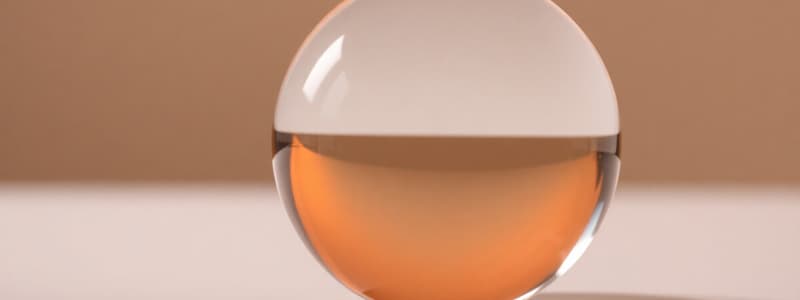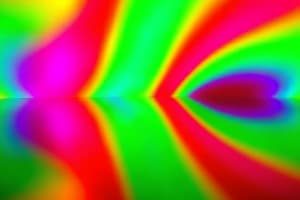Podcast
Questions and Answers
What occurs when the angle of incidence exceeds the critical angle?
What occurs when the angle of incidence exceeds the critical angle?
- Refraction occurs
- The light slows down
- Total internal reflection occurs (correct)
- Light travels in a straight line
Light bends towards the normal when traveling from a less dense medium to a more dense medium.
Light bends towards the normal when traveling from a less dense medium to a more dense medium.
True (A)
What is the critical angle for diamonds?
What is the critical angle for diamonds?
24.4°
Light travels fastest in a ______.
Light travels fastest in a ______.
What is an example of a practical application of total internal reflection?
What is an example of a practical application of total internal reflection?
Match the following mediums with their respective refractive indices:
Match the following mediums with their respective refractive indices:
Describe how light changes its direction when moving from a more dense medium to a less dense medium.
Describe how light changes its direction when moving from a more dense medium to a less dense medium.
The phenomenon when light does not exit a medium and is reflected back is called ______.
The phenomenon when light does not exit a medium and is reflected back is called ______.
Flashcards
Angle of Refraction
Angle of Refraction
The angle at which light bends when passing from one medium to another. It's measured relative to the normal, an imaginary line perpendicular to the surface.
Critical Angle
Critical Angle
The angle of incidence at which the angle of refraction becomes 90 degrees. This means the light ray travels along the boundary of the two mediums.
Total Internal Reflection
Total Internal Reflection
When a light ray traveling from a denser medium to a less dense medium hits the boundary at an angle greater than the critical angle, it is reflected back into the first medium.
Refractive Index
Refractive Index
Signup and view all the flashcards
Fiber Optics
Fiber Optics
Signup and view all the flashcards
Why do diamonds sparkle?
Why do diamonds sparkle?
Signup and view all the flashcards
Speed of Light
Speed of Light
Signup and view all the flashcards
Refraction
Refraction
Signup and view all the flashcards
Study Notes
Total Internal Reflection
- Total internal reflection occurs when light travels from a denser medium to a less dense medium at an angle of incidence greater than the critical angle.
- Light does not refract but reflects back into the denser medium.
- This phenomenon is useful in fiber optics, applications in cars, and tools for viewing the human body.
- The critical angle is the specific angle of incidence at which the angle of refraction is 90°.
- Refractive index of air = 1.00
- Refractive index of water = 1.33
- Critical angle for water entering air = 48.8°
Angle of Refraction
- Light refracts when it changes from one medium to another.
- Refraction happens at an angle.
- If the angle of incidence is 90° (perpendicular to the surface), there is no refraction (no angular change).
- Light bends away from the normal when travelling from a denser medium to a less dense medium.
- Angle of refraction is always larger than the angle of incidence in this situation.
Critical Angle
- As the angle of incidence increases, the angle of refraction also increases.
- Eventually, the angle of refraction is 90 degrees
- The angle of incidence at this point is known as the critical angle.
Fibre Optics
- Fibre optics use total internal reflection to transmit light along thin glass fibres.
- Used in communication (phones, computers, TVs).
- Used in automotive industry instrumentation.
- Used in medical applications ( endoscopes).
Diamonds
- Diamonds sparkle due to their high refractive index.
- This high index results in a small critical angle (24.4°).
- Incident light undergoes total internal reflection many times, causing the sparkling effect.
Practice Questions
- Light travels fastest in a vacuum.
- Light speed changes when changing from one medium to another (e.g., air to water).
- Light changes its direction when moving from one medium to another. This is due to different densities of the two media.
- Refractive index describes how much a medium slows light down and is related to the material’s density.
- Light travels faster through a medium with a lower refractive index.
- Internal reflection occurs when light reflects off a surface, rather than passing through it, and occurs when the angle of incidence is greater than the critical angle.
Studying That Suits You
Use AI to generate personalized quizzes and flashcards to suit your learning preferences.




